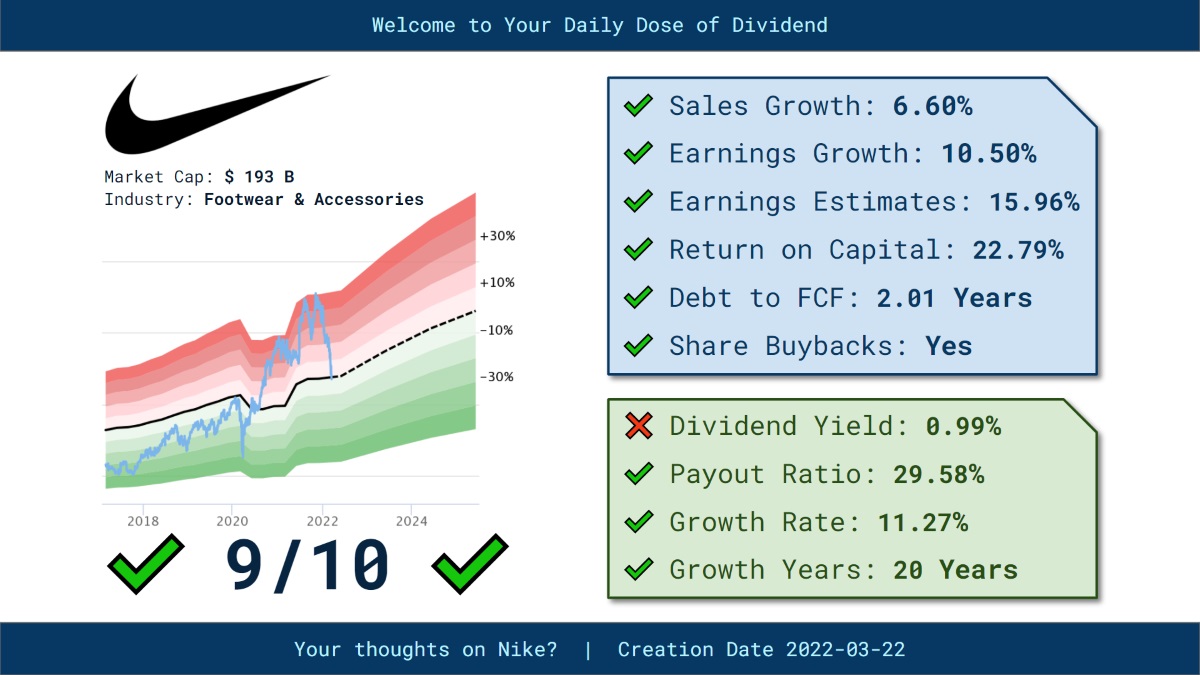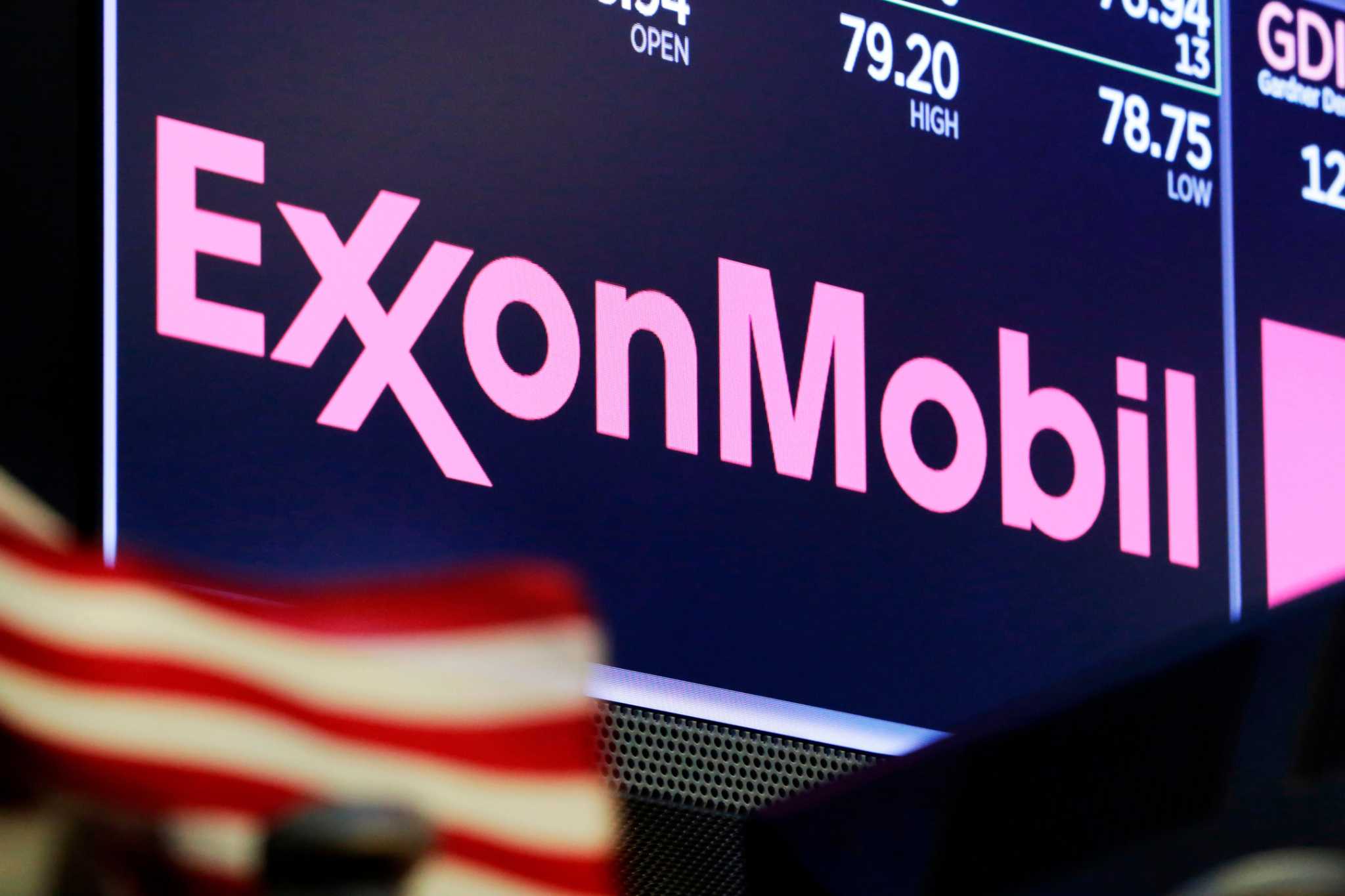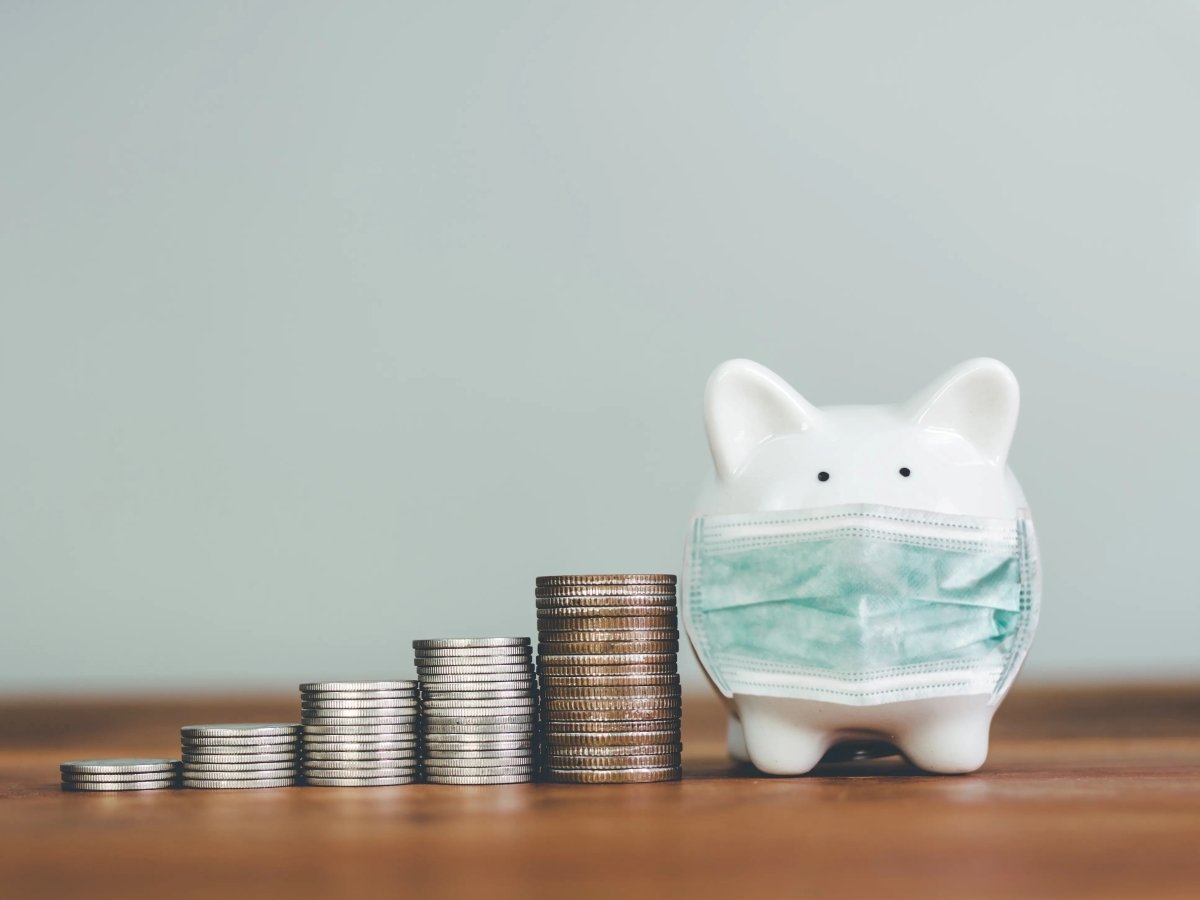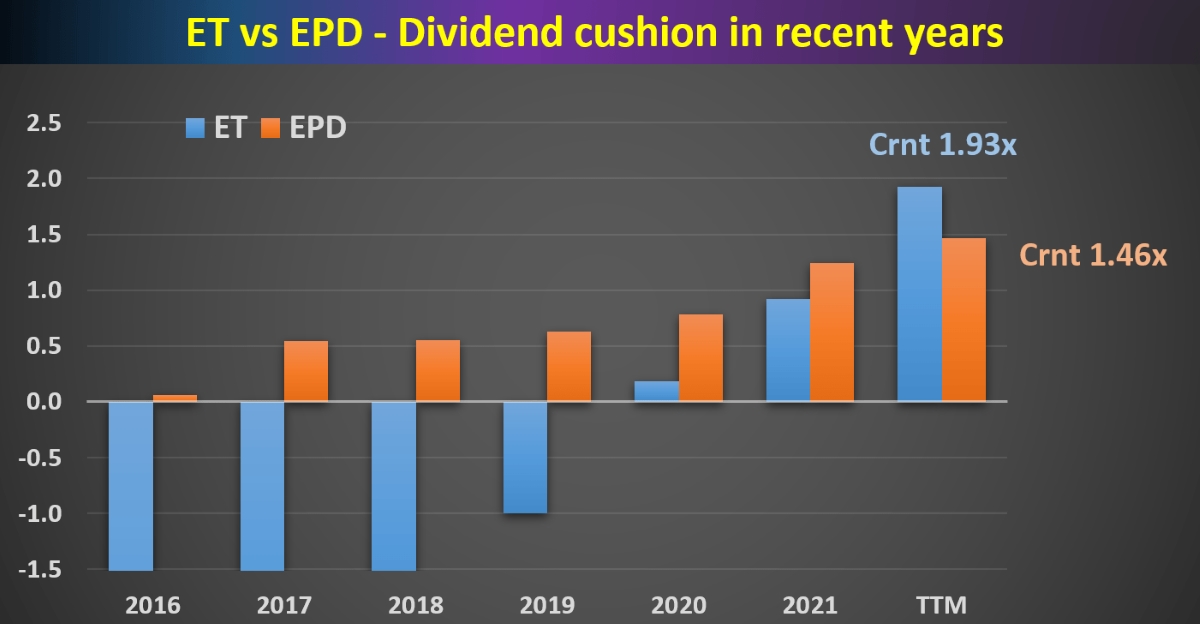

Finance
When Does Nike Pay Dividends
Published: January 3, 2024
Discover when Nike pays dividends and how it impacts your financial portfolio. Explore the finance side of this iconic brand and make informed investment decisions.
(Many of the links in this article redirect to a specific reviewed product. Your purchase of these products through affiliate links helps to generate commission for LiveWell, at no extra cost. Learn more)
Table of Contents
Introduction
When it comes to investing in stocks, there are several factors to consider before making a decision. One key aspect that often catches the attention of investors is the potential for dividends. Dividends are a distribution of profits that a company pays out to its shareholders as a return on their investment.
One prominent company that many investors look to when considering dividends is Nike. Known for its iconic swoosh logo and innovative sports apparel, Nike has established itself as a leader in the athletic industry. But does Nike pay dividends, and if so, when and how much? In this article, we will explore Nike’s dividend policy, its dividend history, and what factors affect dividend payments. We will also compare Nike’s dividend performance with other companies and discuss the future outlook for Nike dividends.
Before we delve into the specifics of Nike’s dividend payments, let’s take a moment to understand the concept of dividends and why they are important to investors.
Understanding Dividends
Dividends represent a share of a company’s profits that are distributed to its shareholders. They are typically paid out on a regular basis, such as quarterly or annually, and can be in the form of cash or additional shares of stock. Dividends serve as a way for companies to reward their shareholders for their investment and provide a steady income stream.
For investors, dividends can be an attractive feature. They offer a source of passive income, especially for those seeking stability and regular returns. Dividend-paying stocks are often considered more reliable and less volatile than non-dividend-paying stocks. Additionally, dividends can be reinvested to compound returns over time, further enhancing an investor’s portfolio.
Now that we have a basic understanding of dividends, let’s turn our attention to Nike’s dividend policy and discover when and how much Nike pays in dividends.
Understanding Dividends
Dividends are an essential component of investing, particularly for those seeking regular income from their investments. Understanding how dividends work can help investors make informed decisions about which stocks to include in their portfolios.
Dividends represent a portion of a company’s profits that it distributes to its shareholders. The amount of the dividend is typically expressed as a fixed amount per share or a percentage of the stock’s price, known as the dividend yield.
When a company decides to pay dividends, it must first declare them. The declaration sets the specific amount or percentage that will be paid to each shareholder. Once declared, shareholders become eligible to receive dividends on a predetermined payment date.
There are different types of dividends, including cash dividends and stock dividends. Cash dividends are the most common form, where shareholders receive a cash payment for each share they own. Stock dividends, on the other hand, involve distributing additional shares of stock to shareholders instead of cash. This can be advantageous for investors as it increases their stake in the company without requiring additional cash outlay.
Dividends are typically paid on a regular basis, either quarterly, semi-annually, or annually. The frequency of dividend payments depends on the company’s dividend policy and financial performance. Companies with consistent and stable cash flows are more likely to pay dividends regularly.
It’s important to note that not all companies pay dividends. Some companies, especially in sectors with high growth potential, may reinvest their profits back into the business to fuel expansion. These companies often prioritize reinvestment over dividend payments, as they believe it will generate greater long-term returns for shareholders.
For investors, dividends can serve as a valuable source of income. They can provide a consistent flow of cash, which can be particularly helpful for retirees or those seeking income stability. Dividends can also help offset potential losses from stock price fluctuations, ultimately reducing overall investment risk.
Investors should consider several factors when evaluating a company’s dividend potential. These factors include the company’s financial health, profitability, and cash flow generation. Companies with a history of consistent dividend payments and a strong balance sheet are more likely to sustain and potentially increase their dividend payments over time.
Now that we have a solid understanding of dividends, let’s explore Nike’s dividend policy and what factors influence the company’s dividend payments.
Nike’s Dividend Policy
When it comes to dividends, Nike has a consistent and investor-friendly approach. The company has a history of returning value to its shareholders through regular dividend payments.
Nike’s dividend policy is focused on providing financial rewards to its shareholders while maintaining a balance between dividend payments and reinvesting in the business for future growth. The company aims to allocate a portion of its earnings to dividends while keeping sufficient funds for research and development, marketing initiatives, and other strategic investments.
In recent years, Nike has demonstrated its commitment to dividends by consistently increasing its dividend payouts. This reflects the company’s confidence in its financial performance and ability to generate strong cash flows.
As of [year], Nike’s dividend yield stands at [dividend yield percentage]. This indicates the dividend income an investor can expect relative to the stock’s current price. A higher dividend yield suggests a higher return on investment for shareholders.
Nike typically pays dividends on a quarterly basis. Shareholders who own Nike stock by the predetermined record date are eligible to receive the next dividend payment. The company announces its dividend declaration and payment dates in advance, ensuring transparency and allowing investors to plan accordingly.
It’s important for investors to understand that dividend payments are not guaranteed and can fluctuate over time. The amount and frequency of dividends are influenced by several factors, including Nike’s financial performance, profitability, cash flow, and strategic priorities.
Nike’s management team carefully considers these factors when deciding on dividend payments. They assess the company’s financial health, capital requirements, investment opportunities, and other obligations to determine an appropriate dividend payout ratio.
While Nike has a track record of increasing its dividends, it’s important to note that past performance is not indicative of future results. Investor sentiment, macroeconomic conditions, changes in industry dynamics, and other factors can influence the company’s dividend policy going forward.
Investors interested in Nike’s dividends should closely monitor the company’s financial reports, earnings announcements, and management commentary to gain insights into its future dividend prospects. Staying informed about Nike’s strategic direction and market trends can help investors make informed decisions about their investments.
Now that we have examined Nike’s dividend policy, let’s delve into the factors that can impact the company’s dividend payments.
Factors Affecting Dividend Payments
Dividend payments are not determined arbitrarily; they are influenced by various factors that affect a company’s financial health and its ability to distribute profits to shareholders. Understanding these factors can provide valuable insights into the sustainability and potential growth of dividend payments. Let’s explore the key factors that can impact Nike’s dividend payments.
Profitability and Earnings Stability: The primary driver of dividend payments is a company’s profitability. Nike’s ability to generate consistent and growing earnings is a crucial factor in determining its dividend payments. Strong earnings reflect the company’s financial success and provide a solid foundation for distributing dividends.
Cash Flow Generation: Nike’s cash flow generation is another critical factor in determining dividend payments. Positive and steady cash flows ensure that the company has sufficient funds to cover its dividend obligations. Investors should assess Nike’s operating cash flow, free cash flow, and cash reserves to evaluate its ability to sustain and potentially increase its dividend payments.
Financial Health: Nike’s financial health, including its debt levels and liquidity, plays a vital role in dividend decisions. A strong balance sheet indicates a company’s ability to meet short-term obligations and withstand economic downturns, which in turn supports the reliability of its dividend payments.
Investment Opportunities: Nike’s dividend payments must strike a balance with its investment needs. The company often reinvests a significant portion of its earnings into research and development, marketing, and expansion initiatives. The availability of attractive investment opportunities can impact dividend amounts as the company may choose to allocate more funds towards growth instead of paying higher dividends.
Economic Conditions: Macro-economic factors, such as economic growth, interest rates, and inflation, can influence dividend payments. In times of economic uncertainty or downturns, companies may adjust their dividend policies to conserve cash or navigate challenging market conditions. Conversely, favorable economic conditions may enable companies like Nike to increase their dividend payments.
Industry and Competitive Landscape: Nike operates in the highly competitive athletic apparel and footwear industry. Industry dynamics, competitive pressures, and changing consumer preferences can impact Nike’s financial performance and, consequently, its dividend payments. Investors should assess Nike’s market position, brand strength, and ability to adapt to industry trends to gauge the company’s dividend sustainability.
Regulatory and Legal Considerations: Companies, including Nike, must comply with various tax and regulatory requirements governing dividend payments. Changes in tax laws or regulations can impact the amount and timing of dividend distributions. Investors should stay aware of any legislative or legal developments that may affect Nike’s dividend policy.
By considering these factors, investors can gain a better understanding of what influences Nike’s dividend payments. However, it is essential to remember that these factors are subject to change, and dividend decisions involve a careful analysis of multiple variables. Investors should conduct thorough research and consult financial professionals before making investment decisions based on dividend expectations.
Now that we have explored the factors that influence dividend payments, let’s turn our attention to Nike’s dividend history and performance in comparison to other companies.
Nike’s Dividend History
Nike has a consistent track record of rewarding its shareholders through dividend payments. While past performance is not indicative of future results, examining the company’s dividend history can provide insights into its commitment to returning value to investors.
Nike initiated its dividend program in [year] and has since steadily increased its dividend payments. This reflects the company’s confidence in its financial performance and its ability to generate strong cash flows.
Over the years, Nike has demonstrated a pattern of annual dividend increases, showcasing its dedication to providing shareholders with a growing stream of income. These increases have outpaced inflation, illustrating the company’s desire to maintain the purchasing power of its dividends.
Looking back, Nike’s dividend history showcases a consistent growth trajectory. The company has consistently raised its dividend payout per share, underscoring its commitment to rewarding long-term investors. The dividend increases reflect Nike’s financial strength and its ability to generate reliable earnings.
It’s important to note that dividend payments are subject to approval by the company’s board of directors and are influenced by various factors, as discussed earlier. While Nike’s dividend history indicates a positive trend, future dividend payments could be adjusted based on business conditions and strategic priorities.
Investors interested in Nike’s dividend history can refer to the company’s financial reports and investor presentations. These sources provide insights into the dividend growth rate, payout ratio, and dividend yield over time. Studying historical dividend data can help investors assess Nike’s consistency and reliability in rewarding shareholders.
Comparing Nike’s dividend history to other companies in the industry can provide additional perspective. Investors can evaluate how Nike’s dividend payments stack up against its peers, considering factors such as dividend yield, growth rate, and payout ratio. This analysis can assist in identifying opportunities and making informed investment decisions within the athletic apparel and footwear sector.
As with any investment decision, it’s crucial to conduct thorough research and consider various factors beyond just dividend history. Factors such as financial performance, competitive positioning, market trends, and future growth prospects should also be taken into account.
Now that we have explored Nike’s dividend history, let’s delve into how the company’s dividend performance compares to other companies in the industry.
Comparing Nike with Other Companies
When evaluating a company’s dividend performance, it’s useful to compare it with other companies in the same industry. By examining how Nike’s dividend metrics stack up against its peers, investors can gain insights into the company’s relative dividend strength and attractiveness. Let’s take a look at how Nike compares to other companies in the athletic apparel and footwear sector.
Dividend Yield: Dividend yield is a key metric investors use to evaluate the return on investment from dividend payments. It is calculated by dividing the annual dividend per share by the stock’s current price. Comparing Nike’s dividend yield with that of its industry peers can provide an indication of its attractiveness as an income-generating investment.
Dividend Growth Rate: Examining the historical dividend growth rate of Nike in comparison to other companies in the industry can offer insights into the company’s consistency and commitment to increasing dividend payments over time. A higher dividend growth rate may indicate a company’s ability to generate strong earnings and provide shareholders with a growing stream of income.
Payout Ratio: The payout ratio, which represents the percentage of earnings distributed as dividends, is another important metric for evaluating a company’s dividend sustainability. Comparing Nike’s payout ratio to industry peers can help determine if the company is maintaining a healthy balance between dividend payments and reinvestment in the business.
Financial Performance: Looking at the financial performance of Nike and its competitors can provide further context for evaluating dividend metrics. Factors such as revenue growth, profitability, and cash flow generation can impact a company’s ability to sustain and potentially increase dividend payments over time.
Competitive Positioning: Assessing Nike’s competitive positioning within the athletic apparel and footwear industry is crucial when comparing dividend performance. A company with a strong market presence, brand loyalty, and innovative products may be better positioned to generate consistent cash flows and sustain dividend payments.
It’s important to note that there is no one-size-fits-all approach to comparing dividend metrics among companies. Each company operates in a unique business environment with its own set of opportunities and challenges. Additionally, the specific goals and preferences of individual investors may vary, influencing their investment decisions.
Investors interested in evaluating Nike’s dividend performance relative to its peers should consider gathering data from reliable financial sources, such as financial statements, dividend histories, and analyst reports. It’s also beneficial to seek insights from financial professionals who specialize in the industry.
By comparing Nike with other companies in the athletic apparel and footwear sector, investors can gain a better understanding of how the company’s dividend performance stacks up. However, it’s important to conduct thorough research and consider other relevant factors, such as the company’s growth prospects, competitive advantages, and overall investment objectives, before making any investment decisions.
Now let’s shift our focus to the future outlook for Nike dividends.
Future Outlook for Nike Dividends
As investors consider potential dividend investments, it is essential to assess the future outlook for a company’s dividends. Analyzing factors that may impact a company’s ability to sustain and potentially increase its dividend payments can provide insights into the attractiveness of the investment. Let’s explore the future outlook for Nike dividends.
Financial Performance: Nike’s financial performance will play a key role in determining its future dividend payments. Investors should monitor the company’s revenue growth, profitability, and cash flow generation to assess its ability to maintain and potentially increase dividends. A healthy financial position is crucial for sustaining dividend payments over the long term.
Growth Opportunities: Nike’s ability to identify and capitalize on new growth opportunities will impact its dividend outlook. Investors should consider the company’s strategies for expanding into new markets, launching new products, and leveraging digital platforms. Higher sales and earnings growth can potentially support increased dividend payments.
Industry Trends: The athletic apparel and footwear industry experiences constant evolution and changing consumer preferences. Monitoring industry trends is critical to assess Nike’s competitive position. Factors such as shifts in consumer demand, emerging technologies, and sustainability considerations can impact Nike’s future growth prospects and, in turn, its dividend outlook.
Investment in Innovation: Nike’s commitment to innovation, product development, and marketing initiatives will influence its long-term growth and dividend potential. The company’s ability to stay ahead of competitors and meet consumer demands through innovative and trend-setting products can position Nike for continued success and potentially higher dividend payments.
Dividend Payout Ratio: The dividend payout ratio, representing the portion of earnings allocated to dividend payments, is an important factor to consider. A sustainable dividend payout ratio ensures that Nike retains enough earnings for reinvestment and future growth while rewarding shareholders with consistent dividends. Investors should monitor this ratio to ensure it remains at a level that allows for dividend stability and potential growth.
Economic Conditions: The broader economic environment can impact Nike’s dividend outlook. Economic factors such as GDP growth rates, interest rates, and global trade dynamics can influence consumer spending patterns and overall demand for Nike’s products. Monitoring these factors can help investors gauge the potential impact on Nike’s future earnings and dividend performance.
Management Decision-Making: Nike’s management team plays a critical role in determining dividend decisions. Investors should assess the company’s strategic direction, capital allocation decisions, and management’s commitment to shareholder value. Transparent communication from management regarding dividend policies can provide confidence in the company’s intention to maintain and, if possible, increase dividends over time.
It is important to note that the future outlook for Nike dividends is subject to change based on various internal and external factors. Unforeseen circumstances, such as economic recessions, changes in consumer behavior, or regulatory shifts, can impact dividend payments. Therefore, investors should regularly monitor company updates, earnings reports, and industry trends to stay informed about any potential changes to Nike’s dividend outlook.
While past performance is not a guarantee of future results, Nike’s consistent dividend track record, strong financial performance, and commitment to innovation position it favorably for potential dividend growth. However, investors should always conduct thorough research and consider the aforementioned factors before making investment decisions based on dividend expectations.
Finally, it is worth noting that seeking financial advice from professionals and consulting with a financial advisor is highly recommended to make well-informed investment decisions based on individual circumstances and goals.
Now, let’s conclude the article.
Conclusion
Nike’s dividend policy and history make it an attractive option for investors seeking consistent income from their investments. The company has a track record of rewarding shareholders through regular dividend payments and has demonstrated a commitment to increasing dividends over time.
Understanding dividends and their importance in investing is crucial for evaluating the potential benefits of owning Nike stock. Dividends provide a source of passive income and can serve as a stabilizing factor in a portfolio, particularly for those seeking a reliable return on investment.
Factors such as profitability, cash flow generation, financial health, investment opportunities, and economic conditions can impact Nike’s ability to sustain and potentially increase its dividend payments. It is important for investors to stay updated on the company’s financial performance, industry trends, and management decisions that can influence future dividend outlook.
Comparing Nike’s dividend metrics to its industry peers provides additional insights into the company’s dividend strength and attractiveness relative to competitors. However, investors should consider various factors beyond just dividend comparisons when making investment decisions.
In conclusion, Nike’s dividend history, consistent dividend increases, and commitment to returning value to shareholders make it an appealing choice for income-focused investors. The company’s financial performance, growth opportunities, and ability to navigate industry trends will play a vital role in determining its future dividend payments.
Investors interested in Nike’s dividends should conduct thorough research, consider their investment objectives, and seek professional advice to make informed decisions. Dividends can be an important aspect of an investment strategy, but they should be evaluated alongside other factors relevant to an investor’s overall financial goals and risk tolerance.
Ultimately, Nike’s strong brand, industry leadership, and focus on innovation position it favorably for potential dividend growth. As with any investment, careful analysis and ongoing monitoring are necessary to make sound investment decisions that align with individual objectives.
Investing involves risks, and it is advisable to consult with financial professionals and consider personal circumstances before making investment decisions. With diligent research and prudent decision-making, investors can harness the potential benefits of Nike’s dividends while building a well-rounded investment portfolio.














